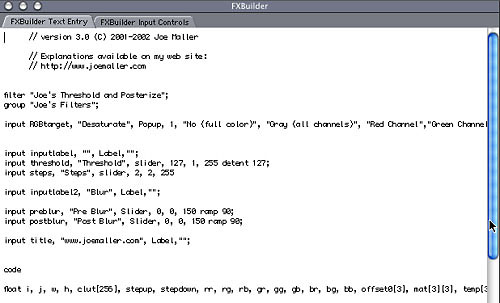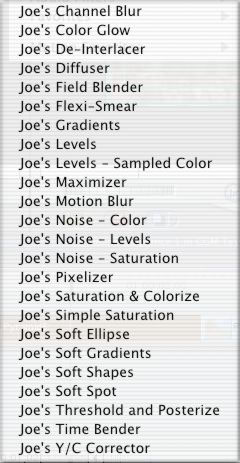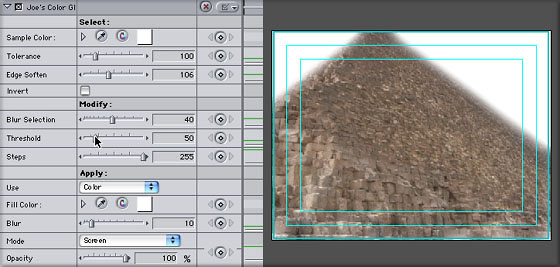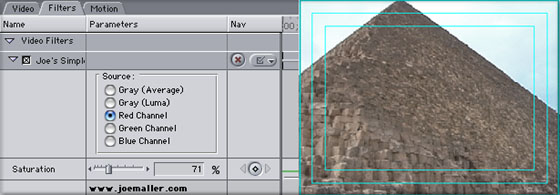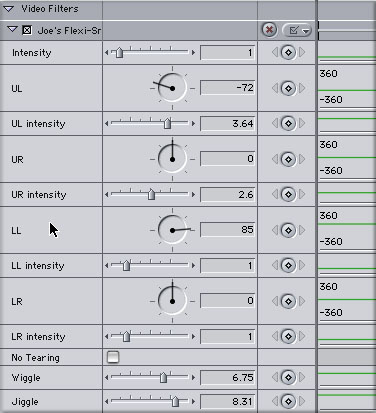
Software Review 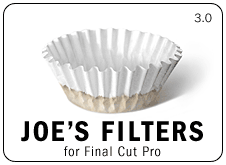
March 4, 2002
Joe's Filters 3.0
Shareware $95
www.joemaller.com
Joe's Filters are a set of 24 plug ins
written in FX Builder for Final Cut ProReviewed by Ned Soltz
Joe Maller knows FX Builder. He demonstrated that knowledge to us in his first release of Joe's Filters 1. Joe's Filter's 3.0 improves upon his first attempt and adds a few interesting twists as well. So, what happened to Joe's Filters 2, you ask? Well, Joe decided just to jump the version to 3.0 for purposes of symmetry with FCP 3.0. Just one glance at his web site (www.joemaller.com) will give you a glipse of a remarkably creative person-a writer, designer, producer, programmer and teacher of an arcane subject (FX Builder). It is even more amazing that such a creative mind emerged from the beige-stucco-red-tile-roof-planned-conformity of Irvine, California. But I digress from the point.Of at least equal significance to Joe's Filters is indeed his web site. Those who wish to master the skill of FX Builder scripting need only spend a few hours with the abundant material which Maller has posted. Furthermore, all of the filters are written in unencoded FX Builder. This means two things: first, you can modify and examine the source code. Highlight the effect in the Effects tab of the Browser and from Edit Menu choose Edit Effects. The FX Builder window will pop up with the source code.
The second advantage of filters scripted in FX Builder is that they are immediately compatible with OS X. There is no need to wait until an OS X version of your favorite AE plug-in to become available.
Joe's Filters 3.0 consists of 24 eclectic filters which enhance the functionality of your FCP image control at a reasonable price.
I'll just choose a few of these to highlight for you.
I find the Time Bender filter the most useful. All of us at one point or another wish to apply variable motion speed to a clip, whether to ramp speed up or down or vary the speed within the clip. The Time Bender accomplishes this with the use of keyframes. Simply apply the Time Bender filter to your clip. Set an initial keyframe of 0 at the beginning of the clip and a keyframe of 100 at the end of the clip. For variation of speed, as in the example below, simply add one or more keyframes. I have applied a control-click on the keyframes and changed them to "smooth", thus allowing me to grab the bezier handles and adjust the speed.
In this example, my clip will speed up and slow down based upon the bezier curves which you see.
There are a few caveats here. Turning on frame blending in a clip with a great deal of motion could produce blurring. The web-site documentation also notes that it might return an FX Script error if another filter is applied before applying the TimeBender filter.
Aficionados of time remapping will immediately ask the difference between this filter and ReelSmart Twixtor. The TimeBender filter does not replace Twixtor. Twixtor has a great many more controls including the ability to remap a clip to an entirely different duration, more exact control over field blending and interpolation and (in After Effects only) the ability to change frame rate. But, for simple speed changes within a clip, this is the first filter I have seen which allows such variability within one clip. For this filter alone, the $95 shareware price is justified.
There are several soft filters. Pictured below is an example of the Soft Ellipse filter and its controls. The position of the soft spot is, of course, keyframeable, thus allowing the matte to conceal the identity of the rogue feline as it walks across my chroma blue fabric.
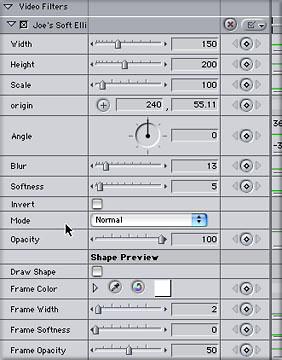
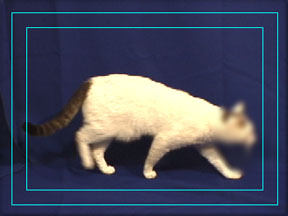
The majority of the filters manipulate various color, channel and saturation options. Here the same rogue feline is stylized by the use of the Threshold and Posterize filter.
Color Glow can add some interesting effects to a shot.
Still other filters manipulate saturation or set gradients within a clip.
The beauty of a package like this is the unlimited possibilities it offers. Tweak the controls (there are often tons of them).
Modify the scripts in FX builder after you have used the on-line tutorials to learn the syntax. Make your productions stand out.
Now, the bottom line. I would spend $95 on this package. Of course, you could always master FX Builder to the same level as Joe Maller and write these or similar filters yourself. The question, of course, is whether you want to. Most of us would prefer to let the expert do the coding and then maybe, if we feel brave enough, just dip our big toe into the FX Builder ocean. These filters are generally intuitive. However, Maller has provided well-written and clearly presented descriptions on the web site.
Is every filter useable? I suppose that depends upon your own needs. Still, I always try to support the small developer or shareware author when he/she has produced a piece of software that extends my creative reach. Such is the case with Joe's Filters 3.0 and I highly commend it to every FCP user.
Go to Joes Filters
Download a Demo of Joe's Filters
Purchase Joe's Filterscopyright © Ned J. Soltz 2002
[Top]
Ned J. Soltz Ned Soltz is passionate about the uses of technology to enhance the creative process. He only wishes that he were more creative. Now that he has a mobile FCP studio on his Powerbook G4, you can catch him on the road at nsoltz@aol.com.
All screen captures, images, and textual references are the property and trademark of their creators/owners/publishers.
This article was originally published at LAFCPUG and is reprinted here with permission.
